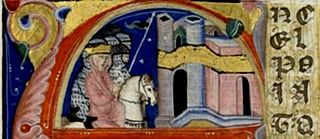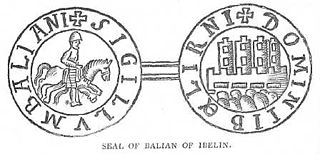Related Research Articles

The Kingdom of Jerusalem, also known as the Crusader Kingdom, was one of the Crusader states established in the Levant immediately after the First Crusade. It lasted for almost two hundred years, from the accession of Godfrey of Bouillon in 1099 until the fall of Acre in 1291. Its history is divided into two periods with a brief interruption in its existence, beginning with its collapse after the siege of Jerusalem in 1187 and its restoration after the Third Crusade in 1192.

The Crusader states, or Outremer, were four Catholic polities that existed in the Levant from 1098 to 1291. Following the principles of feudalism, the foundation for these polities was laid by the First Crusade, which was proclaimed by the Latin Church in 1095 in order to reclaim the Holy Land after it was lost to the 7th-century Muslim conquest. Situated on the Eastern Mediterranean, the four states were, in order from north to south: the County of Edessa (1098–1150), the Principality of Antioch (1098–1268), the County of Tripoli (1102–1289), and the Kingdom of Jerusalem (1099–1291).
Hugh III, also called Hugh of Antioch-Lusignan and the Great, was the king of Cyprus from 1267 and king of Jerusalem from 1268. Born into the family of the princes of Antioch, he effectively ruled as regent for underage kings Hugh II of Cyprus and Conrad III of Jerusalem for several years. Prevailing over the claims of his cousin Hugh of Brienne, he succeeded both young monarchs upon their deaths and appeared poised to be an effective political and military leader.

Alice of Champagne was the queen consort of Cyprus from 1210 to 1218, regent of Cyprus from 1218 to 1232, and regent of Jerusalem from 1243 to 1246. She was the eldest daughter of Queen Isabella I of Jerusalem and Count Henry II of Champagne. In 1210, Alice married her stepbrother King Hugh I of Cyprus, receiving the County of Jaffa as her dowry. After her husband's death in 1218, she assumed the regency for their infant son, King Henry I, but her maternal uncle Philip of Ibelin became the actual head of state administration as bailli (governor).

The Kingdom of Jerusalem, one of the Crusader states that was created in 1099, was divided into a number of smaller seigneuries. According to the 13th-century jurist John of Ibelin, the four highest crown vassals in the kingdom proper were the count of Jaffa and Ascalon, the prince of Galilee, the lord of Sidon, and the lord of Oultrejordain.

There were six major officers of the Kingdom of Jerusalem: the constable, the marshal, the seneschal, the chamberlain, the butler and the chancellor. At certain times there were also bailiffs, viscounts and castellans.

Philip of Milly, also known as Philip of Nablus, was a baron in the Kingdom of Jerusalem and the seventh Grand Master of the Knights Templar. He briefly employed the troubadour Peire Bremon lo Tort in the Holy Land.

The House of Ibelin was a noble family in the Crusader Kingdom of Jerusalem in the 12th century. They rose from relatively humble beginnings to become one of the most important families in the kingdom, holding various high offices and with extensive holdings in the Holy Land and Cyprus. The family disappeared after the fall of the Kingdom of Cyprus in the 15th century.
Hugh of Ibelin was an important noble in the Kingdom of Jerusalem and was Lord of Ramla from 1152-1169.
Baldwin of Ibelin, also known as Baldwin II of Ramla, was an important noble of the Kingdom of Jerusalem in the 12th century and was lord of Ramla from 1169-1186. He was the second son of Barisan of Ibelin, and was the younger brother of Hugh of Ibelin and older brother of Balian of Ibelin. He first appears in the historical record as a witness to charters in 1148.

Balian of Ibelin, also known as Barisan the Younger, was a crusader noble of the Kingdom of Jerusalem in the 12th century. He was Lord of Ibelin from 1170 to 1193. As the leader of the defense of the city during the siege of Jerusalem in 1187, he surrendered Jerusalem to Saladin on 2 October 1187.
John of Ibelin, called the Old Lord of Beirut, was a powerful crusader noble in the 13th century, one of the best known representatives of the influential Ibelin family. The son of Balian of Ibelin and the dowager queen Maria Comnena, he had close ties with the nobility of both Cyprus and Jerusalem, since he was the half-brother of Queen Isabella I of Jerusalem. Before he was 20, he was appointed constable of Jerusalem, and a few years later became Lord of Beirut. John rebuilt Beirut after Saladin's conquest, and established the grand Ibelin family palace. He served as regent of Jerusalem on behalf of his niece Maria of Montferrat from 1205 to 1210 after her mother, Queen Isabella, died. He was also regent for his great-nephew Henry I of Cyprus from 1228 until Henry came of age in 1232. John was known as a principled man, and was seen as the natural leader of the Christian barons in the Holy Land. He resisted the power-seeking of Frederick II, Holy Roman Emperor, in Cyprus, and opposed the imperial forces until King Henry came of age.
John of Ibelin, count of Jaffa and Ascalon, was a noted jurist and the author of the longest legal treatise from the Kingdom of Jerusalem. He was the son of Philip of Ibelin, bailli of the Kingdom of Cyprus, and Alice of Montbéliard, and was the nephew of John of Ibelin, the "Old Lord of Beirut". To distinguish him from his uncle and other members of the Ibelin family named John, he is sometimes called John of Jaffa.

The principality of Galilee was one of the four major seigneuries of the crusader Kingdom of Jerusalem, according to 13th-century commentator John of Ibelin, grandson of Balian. The direct holdings of the principality centred around Tiberias, in Galilee proper, but with all its vassals, the lordship covered all Galilee and southern Phoenicia. The independent Lordship of Sidon was located between Galilee's holdings. The principality also had its own vassals: the Lordships of Beirut, Nazareth, and Haifa.

Philip Ι of Montfort was Lord of La Ferté-Alais and Castres-en-Albigeois 1228–1270, Lord of Tyre 1246–1270, and Lord of Toron aft. 1240–1270. He was the son of Guy of Montfort and Helvis of Ibelin.

The Assise sur la ligece is an important piece of legislation passed by the Haute Cour of Jerusalem, the feudal court of the crusader Kingdom of Jerusalem, in an unknown year but probably in the 1170s under Amalric I of Jerusalem.

The Pactum Warmundi was a treaty of alliance established in 1123 between the Crusader Kingdom of Jerusalem and the Republic of Venice.
Margaret of Antioch-Lusignan, also known as Margaret of Tyre, was an Outremer noblewoman who ruled the Lordship of Tyre in the Kingdom of Jerusalem. A member of the House of Antioch-Lusignan, she married John of Montfort, Lord of Tyre, and was granted rule of the city as widow in 1284. She concluded a truce with the Egyptian sultan Al-Mansur Qalawun and ruled until 1291, when she ceded the lordship and moved to Cyprus.

The timeline of the Kingdom of Jerusalem presents important events in the history of the Kingdom of Jerusalem—a Crusader state in modern day Israel and Jordan—in chronological order. The kingdom was established after the First Crusade in 1099. Its first ruler Godfrey of Bouillon did not take the title of king and swore fealty to the Latin Patriarch of Jerusalem, Daimbert. Godfrey's brother and successor Baldwin I was crowned the first king of Jerusalem without doing homage to the patriarch in 1100. By 1153, Baldwin I and his successors captured all towns on the Palestinian coast with the support of Pisan, Genoese and Venetian fleets and also took control of the caravan routes between Egypt and Syria. The kings regularly administered other crusader states—the Counties of Edessa and Tripoli and the Principality of Antioch—on behalf of their absent or underage rulers.
The siege of Tyre took place from 29 November 1111 to 10 April 1112 when the coastal city of Tyre, in what is now Lebanon and was then in the hands of the Fatimid Caliphate, was besieged by the Crusader King Baldwin I of Jerusalem. In the previous years, Baldwin had taken the cities of Acre, Tripoli, Sidon and Beirut from the Fatimids. Tyre was besieged by land, leaving the sea open as Baldwin lacked a fleet. Although the Fatimid navy failed to help the city, the siege was relieved by the Turkoman ruler of Damascus, Toghtekin. Toghtekin installed his own governor in the city, which however remained nominally under Fatimid sovereignty. Fatimid rule was restored in 1122, but finally the city was lost to the Crusaders in 1124.
References
- ↑ Maalouf 1984, p. 47.
- 1 2 Maalouf 1984, p. 89.
- ↑ Maalouf 1984, pp. 47, 89.
- ↑ Maalouf 1984, p. 50.
- ↑ Jotischky 2017, p. 67.
- 1 2 3 Maalouf 1984, pp. 80–81.
- ↑ Prawer 1998, pp. 143–144.
- ↑ Maalouf 1984, p. 90.
- ↑ Jacoby 2016, p. 182.
- ↑ Jotischky 2017, p. 79.
- 1 2 Maalouf 1984, p. 95.
- ↑ Jotischky 2017, pp. 162–163.
- ↑ Jotischky 2017, pp. 163–164.
- 1 2 3 4 5 Jacoby 2016, p. 183.
- ↑ Maalouf 1984, p. 96.
- ↑ Maalouf 1984, pp. 96–97.
- ↑ Prawer 1998, pp. 85–86.
- ↑ Maalouf 1984, p. 97.
- ↑ Prawer 1998, pp. 146–147.
- 1 2 3 Jacoby 2016, p. 186.
- ↑ Jacoby 2016, p. 188.
- 1 2 3 4 Prawer 1998, p. 145.
- ↑ Prawer 1998, p. 146.
- 1 2 Prawer 1998, p. 148.
- ↑ Jacoby 2016, pp. 183–184.
- ↑ Jacoby 2016, p. 184.
- ↑ Jacoby 2016, pp. 181, 184.
- ↑ Jacoby 2016, pp. 186–187.
- 1 2 3 Jacoby 2016, p. 187.
- ↑ Prawer 1998, p. 149.
- 1 2 3 4 5 Edbury 2001, pp. 25–26.
- ↑ Metcalf 1995, p. 96.
- 1 2 3 Edbury 1993, p. 91.
- 1 2 3 4 Edbury 1993, pp. 97–98.
- 1 2 3 4 5 Prawer 1998, p. 144.